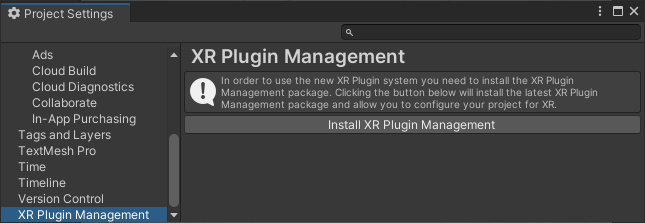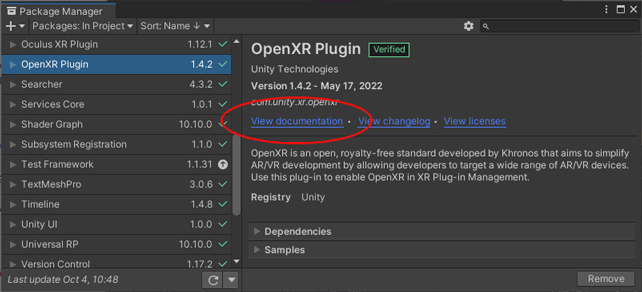Choose and configure XR provider plug-ins
Use the XRAn umbrella term encompassing Virtual Reality (VR), Augmented Reality (AR) and Mixed Reality (MR) applications. Devices supporting these forms of interactive applications can be referred to as XR devices. More info
See in Glossary Plug-inA set of code created outside of Unity that creates functionality in Unity. There are two kinds of plug-ins you can use in Unity: Managed plug-ins (managed .NET assemblies created with tools like Visual Studio) and Native plug-ins (platform-specific native code libraries). Glossary Plug-inA set of code created outside of Unity that creates functionality in Unity. There are two kinds of plug-ins you can use in Unity: Managed plug-ins (managed .NET assemblies created with tools like Visual Studio) and Native plug-ins (platform-specific native code libraries). More info
See in Glossary Management settings to choose and configure XR provider plug-ins.
Provider plug-ins are packages created to support XR devices and platforms. Use the XR Plug-in Management settings to manage which XR devices and platforms your project supports. You can also configure important settings for these XR provider plug-ins in this section.
To learn about the provider plug-ins Unity provides, refer to Provider plug-ins and XR provider plug-in framework.
The following sections outline how to Enable XR provider plug-ins, Configure provider plug-in settings, and Validate your project. For more information about the settings you can configure, refer to XR Plug-in Management settings.
Prerequisites
Before you can enable XR plug-ins, you must install the XR Plug-in Management package. You can install the package directly from the Project SettingsA broad collection of settings which allow you to configure how Physics, Audio, Networking, Graphics, Input and many other areas of your project behave. XR Plug-in Management package. You can install the package directly from the Project SettingsA broad collection of settings which allow you to configure how Physics, Audio, Networking, Graphics, Input and many other areas of your project behave. More info
See in Glossary window, as follows:
Open the Project Settings window (menu: Edit > Project Settings).
-
Select XR Plug-in Management from the list of settings areas along the left side of the settings window.

Before installing the XR Plug-in Management package If necessary, click Install XR Plug-in Management.
Install platform modules
Depending on the platforms your project targets, you might need to install additional platform modules (for example, Android or iOS) from the Unity Hub. Refer to Add modules in the Unity Hub documentation for instructions.
Enable provider plug-ins
You must enable each provider plug-in your project targets using XR Plug-in Management.
To enable provider plug-ins:
- Open the Project Settings window (menu: Edit > Project Settings).
- Select XR Plug-in Management from the sections on the left side of the Project Settings window.
- Select the tab for your target build platform. For example, to enable a plug-in for an Android device, click the tab with the Android icon .
- Use the corresponding checkbox to enable your desired provider plug-in(s) from the list of Plug-in Providers.
When you enable a plug-in, XR Plug-in Management installs the associated package.
Notes:
- Disabling a provider doesn’t remove the package. To remove a provider plug-in, remove the associated package with the Package Manager.
- If a provider isn’t in the list, you might need to install the associated package with the Package Manager. Some device makers distribute their provider plug-in packages directly, rather than via Unity.
Configure provider plug-in settings
For each enabled plug-in provider, you can configure provider-specific settings as follows:
- In the XR Plug-in Management menu, select the name of the provider plug-in.
- If present, select the tab for the platform build target. For example, to configure settings for Android devices, click the tab with the Android icon . (The tabs are only shown when a plug-in supports more than one build target.)
- Configure the settings as required.
To learn about settings for a specific provider, refer to the documentation of the individual plug-in. You can access provider documentation from XR packages or with the Documentation link in the Package Manger, as shown in the following image:

Validate your project
Some provider plug-ins and other packages implement project validation checks to help ensure that you’ve set up your project correctly. You can view the status of these checks in the Project Validation section under XR Plug-in Management in the Project Settings window.
If a validation check has a Fix button next to it, you can click the button to automatically fix the issue. Otherwise, you must fix the issue manually. Clicking Edit opens the settings UI(User Interface) Allows a user to interact with your application. Unity currently supports three UI systems. More info
See in Glossary to the appropriate section so that you can make any needed changes.
The way you resolve project validation issues depends on the severity of the issue:
- You must correct validation checks marked with a red stop icon.
- You can ignore or defer checks marked with a yellow warning icon, but fixing them results in better performance or compatibility.
To learn more about the validation system rules and status icons, refer to Project validation reference.
Additional resources
- XR packages
- XR Plug-in Management settings
- Advanced plug-in management (XR Plug-in Management package documentation)